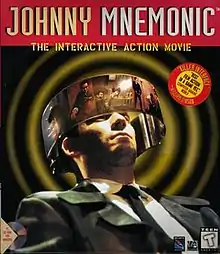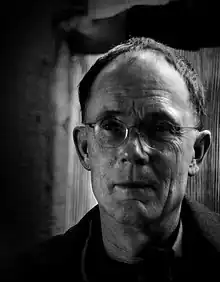Johnny Mnemonic (video game)
Johnny Mnemonic: The Interactive Action Movie is a point-and-click adventure science fiction video game directed by Douglas Gayeton for Macintosh, Microsoft Windows and released by Sony Imagesoft on May 26, 1995. Based on the 1981 short story of the same name by William Gibson, the game has the player take the role of the title character.
| Johnny Mnemonic | |
|---|---|
 | |
| Developer(s) | Propaganda Code |
| Publisher(s) | Sony Imagesoft |
| Director(s) | Douglas Gayeton |
| Producer(s) |
|
| Writer(s) |
|
| Composer(s) | Josh Mancell |
| Engine | Cineactive |
| Platform(s) | Macintosh, Microsoft Windows |
| Release | May 26, 1995 |
| Genre(s) | Interactive movie |
| Mode(s) | Single-player |
Development for the game was done by American studio Propaganda Code, the gaming division of Propaganda Films. The budget for the game was $3 million. Filming took place at the Ambassador Hotel in Los Angeles, California for fifteen days.
Johnny Mnemonic received polarized reviews from video game critics. After its release, Sony Imagesoft was folded into Sony Computer Entertainment of America and Propaganda Code closed down, having only made one game.
Gameplay
Johnny Mnemonic: The Interactive Action Movie is a point-and-click adventure video game. The game has no user interface displayed, instead changing the aspect ratios on the screen to show when to do any action commands.[1]
Plot
Development



Johnny Mnemonic was developed by Sony Imagesoft. The interactive movie was shot by the production company Propaganda Films, known for filming commercials for AT&T and Coca-Cola and filmed 1990's Wild at Heart. Along with shooting the footage for the game, they also developed the game under their unit Propaganda Code.[2] The story was based on a 1981 short story by William Gibson, who had coined the term "cyberspace" and who served as scriptwriter for the film.[3] Around the same time as the video games production, Sony Pictures was making a movie adaption, starring Keanu Reeves.[4] Production costs for filming and tech development reached $3 million.[5]
The script was written by Douglas Gayeton and John Platten. The script numbered roughly 145 pages when completed.[2] It took four weeks to write a script, and Gayeton took into account that he knew he'd be unable to ask for more money for reshoots.[6] The original concept for the game was to use the same sets as the movie but were unable to due to multiple issues, including contractional issues and the movie being behind schedule.[5] Filming for the game took place in the Ambassador Hotel in Los Angeles, California.[2] The design for the hotel was done by Jean-Philippe Carp, previously the designer for the French black comedy Delicatessen. Carp used adornments like aquarium table lamps and neon video screens to give the hotel a futuristic look.[2] Filming lasted fifteen days. Seventy camera set-ups were done for each day of shooting. Propaganda Code executive producer Jonathan Wiedeman noted the potential for continuity issues between scenes due to the multiple branches, which was addressed by having actors tone down any extreme emotional reads.[2][7] The game saw the first use of the interactive movie engine Cineactive, developed by Evolutionary Publishing, which Sony licensed for use in the title.[8][9]
Christopher Gartin was cast in the role of Johnny Mnemonic. His previous work included an appearance on the soap opera Melrose Place. Other cast members included singer and actor Issac Hayes, former Los Angeles Lakers player Kurt Rambis, Doug Llewelyn from The People's Court, and Penthouse model and 1993's Pet of the Year Julie Strain.[10]
Josh Mancell was the composer for the game.[11] The soundtrack to the game did not feature any of the music used in the soundtrack for the movie. Columbia Records vice president of soundtracks Maureen Crowe said that they tried to incorporate the music used in the movie, but the game was too far ahead. She also explained the two works were thematically different and the same music might not have worked for both.[12] The band Devo was brought on to do the music instead.[5]
Interactive movies such as Johnny Mnemonic were often created out of necessity, due to CD-ROMs being forced to compress long movie sequences into low quality files, which developers would combine with graphics, sound and text in what Techtsy describes as "the collage technique".[13]
Steven Yee, director of marketing for Sony New Technologies commented that the film, the CD-ROM and an Internet game entitled Nethunt (where players answered traversed websites to answer questions) "amount to three different views of the Internet and Gibson's short story".[14]
Release

The game was first announced in a pre-launch on March 15, 1995 at the New Media Expo at the Writers Guild booth.[15][16] It was later shown at the first E3 in May the same year.[17] Sean McGowan, an analyst for research boutique Gerard Klauer Mattison & Co. estimated that the game needed to sell 100,000 copies to break even.[18]
William Gibson helped promote the game by making an on-line appearance on CompuServe and ZiffNet on May 18, 1995.[19] The game was shipped on May 26, 1995.[20] Shortly after its release, Douglas Gayeton left Propaganda Films to work on other projects. The developer Propaganada Code also closed, with Johnny Mnemonic as their only game.[5] In July 1995, Sony Imagesoft was folded into Sony Computer Entertainment of America due to Sony Corporation of America restructuring their video games operations to prepare for the release of the PlayStation.[21] The game was planned as a launch title for the PlayStation but was never released.[22] A version for the Sega CD was also announced but was also unreleased.[23]
Reception
| Publication | Score |
|---|---|
| AllGame | |
| Computer Gaming World | |
| Edge | 3/10[26] |
| PC Gamer (US) | 80%[27] |
| Electronic Entertainment | C−[28] |
| Entertainment Weekly | B[10] |
| MacUser | 1/5[29] |
Johnny Mnemonic received polarized reviews from video game critics. Christopher Allen from Allgame described the game as "a painful example of why FMV so often fails to achieve significant interactive gameplay."[24] The Los Angeles Times felt the game found ways to make the generally "deadly" genre of interactive movies interesting and exciting.[4] The Seattle Times felt it was a "breakthrough" as the first electronic game to be considered a true interactive movie with Hollywood standards.[30] Andy Grieser from The Chicago Tribune was so engrossed in the "addictive" title that he began shouting out loud during the fight sequences.[31]
Charles Ardai for Computer Gaming World remarked that the game suffered from "Dragon's Lair syndrome", noting that the player is only given one chance of success or else clicking the mouse too early or too late causes a game over.[25]
Hardcore Gamer considered the game to be one of the lowest points for publisher Sony Imagesoft.[32]
References
- Caruso, Denise (May 22, 1995). "TECHNOLOGY: DIGITAL COMMERCE; Innovation appears to be a scarce commodity. How will multimedia's new talent emerge from the interactive ooze?". The New York Times. Archived from the original on May 26, 2015. Retrieved April 16, 2019.
- Wilson, Johnny L.; Brown, Ken (February 1995). "Johnny Mnemonic". Computer Gaming World. No. 127. pp. 34–36.
- RICLEYVA (June 2, 1995). "First interactive movie game is now available". The Kokomo Tribune.
- Colker, David (May 26, 1995). "CD-ROM Review : CD-ROM of 'Mnemonic' in the Stores". Los Angeles Times. Retrieved April 23, 2019.
- Carless, Simon (October 23, 2007). "Q&A: Douglas Gayeton On Johnny Mnemonic's CD-ROM Wetware". GameSetWatch. Archived from the original on April 16, 2019. Retrieved April 18, 2019.
- Evenson, Laura (1995-05-23). "'Mnemonic' in Power Drive / Creator of ground-breaking CD-ROM rides the fast lane". SFGate. Retrieved 2019-04-23.
- Staff (July 1995). "Masters of the Game". Canadian Business. Retrieved April 23, 2019.
- "CineACTIVE". old.siggraph.org. Retrieved 2019-04-23.
- "Corrections". The New York Times. May 29, 1995. ISSN 0362-4331. Retrieved April 23, 2019.
- Nashawaty, Chris (June 2, 1995). "Johnny Mnemonic". Entertainment Weekly. Retrieved April 14, 2019.
- Mancell, Josh (May 2003). "Scoring the Unknown". Game Developer. p. 22.
- Atwood, Brett (May 13, 1995). "Sony Arms Link In Soundtrack Push Online Promo For 'Johnny Mnemonic'". Billboard. pp. 12, 123.
- Pisarski. "Technika kolażu w hipertekście i nowych mediach". Techsty (in Polish). Retrieved April 23, 2019.
- Jensen, Jeff (May 29, 1995). "'JOHNNY MNEMONIC' TURNS CYBERFEARS INTO CYBERMARKETING". AdAge. Retrieved April 23, 2019.
- Variety Staff (March 19, 1995). "Vidgamers Wont Play By Hollywood's Rules". Variety. Retrieved April 16, 2019.
- ERCILIA, MARIA (March 21, 1995). "San Francisco urgente". Folha De S.Paulo.
- Evenson, Steve (May 8, 1995). "E3 Multimedia Show Clicks With the Little Guys / A preview of first-ever show in Los Angeles". San Francisco Chronicle. Retrieved April 16, 2019.
- Van Bakel, Rogier (June 1, 1995). "Remembering Johnny". Wired. Archived from the original on November 6, 2015. Retrieved April 16, 2019.
- "Cyberpunk Author William Gibson To Discuss Johnny Mnemonic On-Line". Computer Gaming World. p. 26.
- Rigdon, Joan (June 18, 1995). "THE FUTURE IS LATE IN HIGH-TECH GAMES". Deseret News. Retrieved April 18, 2019.
- "Sony in Disarray on Eve of PlayStation Debut". Television Digest with Consumer Electronics: 9. August 14, 1995. ISSN 0497-1515.
- The Whizz; Bruised Lee (June 1995). "The PlayStation Powers Up". GamePro. pp. 30–31.
- "Preview". Video Games: The Ultimate Gaming Magazine. No. 76. May 1995. p. 58.
- Allen, Christopher. "Johnny Mnemonic: The Interactive Action Movie". Allgame. Archived from the original on November 17, 2014.
- Ardai, Charles (August 1995). "Don't Let It Go To Your Head". Computer Gaming World. No. 133. pp. 84–86.
- "Test Screen". Edge. No. 23. August 1995. pp. 70–71.
- Wolfe, Scott (September 1995). "Johnny Mnemonic". PC Gamer. Vol. 2, no. 9. p. 112.
- Klett, Steve (August 1995). "Johnny Mnemonic". Electronic Entertainment. Archived from the original on November 13, 1996.
- Levitus, Bob (January 1996). "The Game Room". MacUser. Vol. 12, no. 1. p. 134.
- Gelmis, Joseph (June 4, 1995). "Johnny Mnemonic Is True Interactive CD-Rom Movie". The Seattle Times.
- Grieser, Andy (June 16, 1995). "JOHNNY MNEMONIC CD-ROM IS AS MIND-BLOWING AS THE MOVIE". The Chicago Tribune.
- Kent, Steven (December 2006). "Zero to 60 In One Generation". Hardcore Gamer. Vol. 2, no. 6. pp. 44–48.